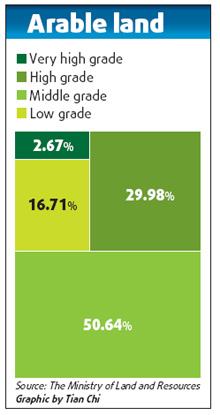Government and Policy
Rating system to help protect prime farmland
By Wang Qian (China Daily)
Updated: 2009-12-25 08:00
 |
Large Medium Small |
China has released a rating system to assess land quality, in the first such effort in decades to protect shrinking arable land from being used for non-agricultural purposes.

"Based on the land quality rating, we will map out a national arable land protection zone to cover most arable land of high quality and prevent it from being lost to urbanization, thus ensuring our food security," Hu Cunzhi, chief planner of the Ministry of Land and Resources, said during a press conference in Beijing yesterday.
According to the rating, the land has been categorized into 15 grades. Grade 1 is for arable land that is capable of annually producing over 21000 kg of grain per hectare, with each subsequent category having grain yields of 1500 kg less per hectare between grades, Hu said.
"The result was not optimistic - only around 30 percent of the land was better than grade 8 and average land quality was in the grade 10 range," Hu said.
Most high-grade land was located in developed regions such as Guangdong, Fujian and Zhejiang provinces, he said.
The quantity and quality of the arable land will be included in the performance indicator system of local authorities soon, Hu said.
The country's arable land bank decreased by 40,700 hectares in 2007, to 121.73 million hectares, but was still above the 120-million hectares required to feed the country's population, according to data from the ministry.
The total arable land area at the end of 2006 was 122 million hectares.
| ||||
The exercise took nearly a decade and entailed an investment of 120 million yuan ($17.6 million), Hu said.
Yun Wenjudeputy director of Land Consolidation and Rehabilitation Center at the ministry, said the rating would be updated every six years to reflect changes in land quality.
"We hope that the land area will not decrease due to the fast economic development," Yun said.
China's grain output is expected to touch 550 billion kg by 2020, meaning a productivity program for 50 billion kg output growth over the next decade, the National Development and Reform Commission said last month.
"The land quality rating will play an important role in the productivity program, mapping out potential high quality land," Yun said.











